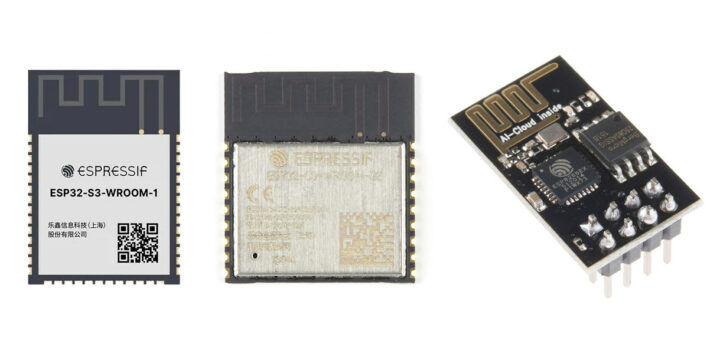The ESP32-S3 chip is equipped with an Xtensa 32-bit LX7 dual-core processor clocked at up to 240 MHz, supports 2.4 GHz Wi-Fi and Bluetooth 5 LE, and boasts AI instructions, as well as a reliable security encryption engine, specially built for the AIoT market.
Modules based on the ESP32-S3 processor bring many benefits to designers with support for Bluetooth Long Range mode, plenty of resources with 512 KB SRAM (TCM), 45 programmable GPIO pins, and rich communication interfaces. They can also handle high-speed Octal SPI flash with higher capacities, as well as off-chip PSRAM.
 So, what are the differences between the new ESP32-S3 modules, and typical ESP32-C3 and ESP8266 modules? Let’s find out.
So, what are the differences between the new ESP32-S3 modules, and typical ESP32-C3 and ESP8266 modules? Let’s find out.
| Module's CPU | ESP32-S3 | ESP8266 | ESP32-C3 |
|---|---|---|---|
| Frequency Range | 2400~2483.5MHz |
||
| Operating Temperature | -40~85°C |
||
| Storage Temperature | -40~125°C, <90%RH |
||
| Power supply range | 3.0V - 3.6V, 500mA+ |
||
| Supported Interfaces | UART, GPIO, ADC, PWM, I2C, I2S, SPI, LCD, DVP, RMT, SDIO, USB OTG, MCPWM DMA, TWAI | UART, GPIO, ADC, PWM, SPI, I2C |
|
| Number of IOs | 38 | 9 | 22 |
| Typical PSRAM | 64 MBit | - |
|
| Typical SPI flash | 64 Mbit | 16Mbit/32Mbit |
|
| CPU | Dual-core Xtensa LX7 @ up to 240 MHz with additional vector instructions for AI acceleration ULP core to handle low power modes | Single-core Xtensa L106 32-bit RISC microprocessor @ 160 MHz | Single 32-bit RISC-V (RV32IMC) core @ 160 MHz |
| On-chip RAM | 512KB | 160KB | 400KB |
| On-chip ROM | 384KB | N/A |
|
| WiFi | WiFi 4 (802.11n) |
||
| Bluetooth | BLE 5.0 | N/A | BLE 5.0 |
| Power Consumption | |||
| Modem sleep | 20mA | 15mA |
|
| Light sleep | 240μA | 2mA | 130μA |
| Deep sleep | 8μA | 20μA | 5μA |
| Hibernation | 7μA | - |
|
| Power off | 1μA | 0.5μA | 1μA |

Jean-Luc started CNX Software in 2010 as a part-time endeavor, before quitting his job as a software engineering manager, and starting to write daily news, and reviews full time later in 2011.
Support CNX Software! Donate via cryptocurrencies, become a Patron on Patreon, or purchase goods on Amazon or Aliexpress





The C3-12F overall looks like a good balance of features and capacity, appearing as being more capable than the ESP-12F in the same form factor for significant power savings. I still with there would be a standard way to program them in field without adding tons of components around. Ideally having 6 small holes on the PCB to insert a tiny connector that manipulates GPIO0, EN, Tx, Rx would be cool as it would alleviate the need for an onboard usb-serial adapter and keep the form factor small.
Form factor is a bit larger, but I found this one checks all of the boxes for me. USB is built-in to the S2 SoC: S2 mini — WEMOS documentation
I agree that it looks really great, and there’s zero useless component on it. Thank you for the link!
Credit CNXSoft, too, he covered it not too long ago – $4 Lolin S2 Mini ESP32-S2 WiFi IoT board works with Wemos D1 Mini shields – CNX Software (cnx-software.com)
And I responded and then my memory vanished! Probably by then I couldn’t find one for sale or found it too expensive to just add to my junk box.
There should also be a row (or article paragraph) for commonly supported programming environments. Sort of an encapsulation of Adafruit’s caution when common Arduino or RPi libraries aren’t compatible.
One thing I still don’t get – what’s the difference between the S3 12K and 32S versions.
Or 12F and 32S in the case of the C3.
Is it only the number of expose IO pins?